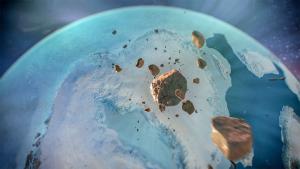Content:
On a bright July day 2 years ago, Kurt Kjær was in a helicopter flying over northwest Greenland—an expanse of ice, sheer white and sparkling. Soon, his target came into view: Hiawatha Glacier, a slow-moving sheet of ice more than a kilometer thick. It advances on the Arctic Ocean not in a straight wall, but in a conspicuous semicircle, as though spilling out of a basin. Kjær, a geologist at the Natural History Museum of Denmark in Copenhagen, suspected the glacier was hiding an explosive secret. The helicopter landed near the surging river that drains the glacier, sweeping out rocks from beneath it. Kjær had 18 hours to find the mineral crystals that would confirm his suspicions.
What he brought home clinched the case for a grand discovery. Hidden beneath Hiawatha is a 31-kilometer-wide impact crater, big enough to swallow Washington, D.C., Kjær and 21 co-authors report today in a paper in Science Advances. The crater was left when an iron asteroid 1.5 kilometers across slammed into Earth, possibly within the past 100,000 years.
Though not as cataclysmic as the dinosaur-killing Chicxulub impact, which carved out a 200-kilometer-wide crater in Mexico about 66 million years ago, the Hiawatha impactor, too, may have left an imprint on the planet's history. The timing is still up for debate, but some researchers on the discovery team believe the asteroid struck at a crucial moment: roughly 13,000 years ago, just as the world was thawing from the last ice age. That would mean it crashed into Earth when mammoths and other megafauna were in decline and people were spreading across North America.


